Birdfinding.info ⇒ Due to persistent persecution for the pet trade, the Common Hill Myna is uncommon across much of its range. Areas where it remains locally common include: Chitwan National Park in central Nepal; Mahananda Wildlife Sanctuary and Buxa Tiger Reserve in West Bengal; Manas, Nameri, and Kaziranga National Parks in Assam; South Andaman and Little Andaman Islands; Khao Yai and Kaeng Krachan National Parks in central Thailand; the Angkor Wat area and several parks and reserves in northern Cambodia; the Puerto Princesa area of Palawan; and Singapore Botanic Gardens, Telok Blangah Hill Park, Bukit Timah, and the Central Catchment Nature Reserve in Singapore. In Miami, Florida, the most consistent sites over the years have been Fairchild Tropical Botanical Garden and Matheson Hammock.
Common Hill Myna
Gracula religiosa
Southeastern Asia from India to Indonesia, mainly in humid foothill forests.

Approximate historical range of the Common Hill Myna. © BirdLife International 2018
On the Indian subcontinent it has become scarce and local, mainly in the foothills of the Himalayas from central Nepal eastward; also very locally in east-central India from easternmost Telangana to Bangladesh; more widespread in India’s eastern provinces.
In Southeast Asia, generally distributed across Myanmar, Laos, Thailand, and Cambodia, south to Singapore, and locally north and east into some border areas of China (Yunnan and Guangxi) and Vietnam.
Resident on many islands of the Andaman Sea, including the Andaman and Nicobar Islands and near-coastal islands of Myanmar and Thailand.
In Indonesia, generally distributed across Sumatra, Java, Borneo, and many smaller adjacent islands, east to Palawan, Culion, and Busuanga in the Philippines.
Introduced populations have been noted in a few urban areas, including Macau, China, Honolulu, Hawaii, and San Juan, Puerto Rico, but most have failed to become self-sustaining. A small population in South Miami and Kendall, Florida, may be the exception, as it has persisted for several decades.
“Enggano Hill Myna” (G. r. enganensis), of Enggano Island west of southern Sumatra, was traditionally considered a separate species, but it does not appear to differ either visually or vocally from the other subspecies classified together with religiosa.
Identification
A large, robust myna with glossy, black plumage, a heavy, bright orange bill, yellow-orange legs, and a peculiar “head-dress” of yellow-orange wattles that extend like flaps behind its eyes and around the back of its head.
The wings have a broad white bar across the base of the primaries that is usually visible at rest and conspicuous in flight.

Common Hill Myna, showing a bluish gloss on the upperparts, a purplish gloss on the underparts, and a white patch at the base of the primaries. (Satchari National Park, Bangladesh; March 4, 2019.) © Naifs Ameen
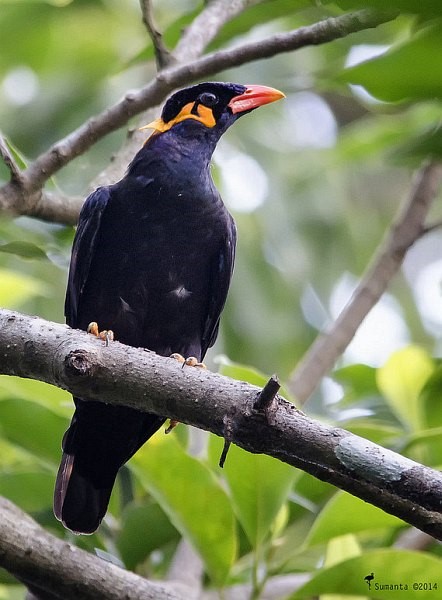
Common Hill Myna, showing the peculiar formation of its “head-dress” wattle. (Pampasar, Satkosia Tiger Reserve, Odisha, India; October 1, 2014.) © Sumanta Pramanick
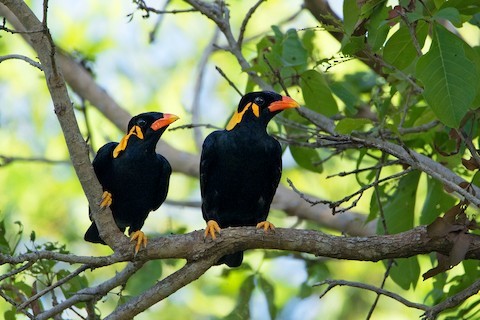
Common Hill Myna—note that the bird on the left apparently has a longer wattle. (Surat Thani, Thailand.) © Ayuwat Jearwattanakanok
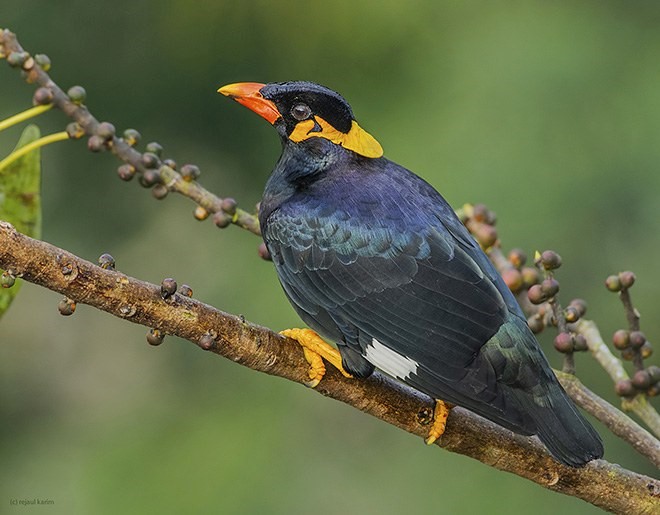
Common Hill Myna, showing purplish and greenish gloss on the upperparts, and a white patch at the base of the primaries. (Guwahati Medical College, Assam, India; January 22, 2020.) © Rejaul Karim

Common Hill Myna, showing purplish and bluish gloss on the upperparts, and a white patch at the base of the primaries. (Guwahati Medical College, Assam, India; December 22, 2019.) © Rejaul Karim
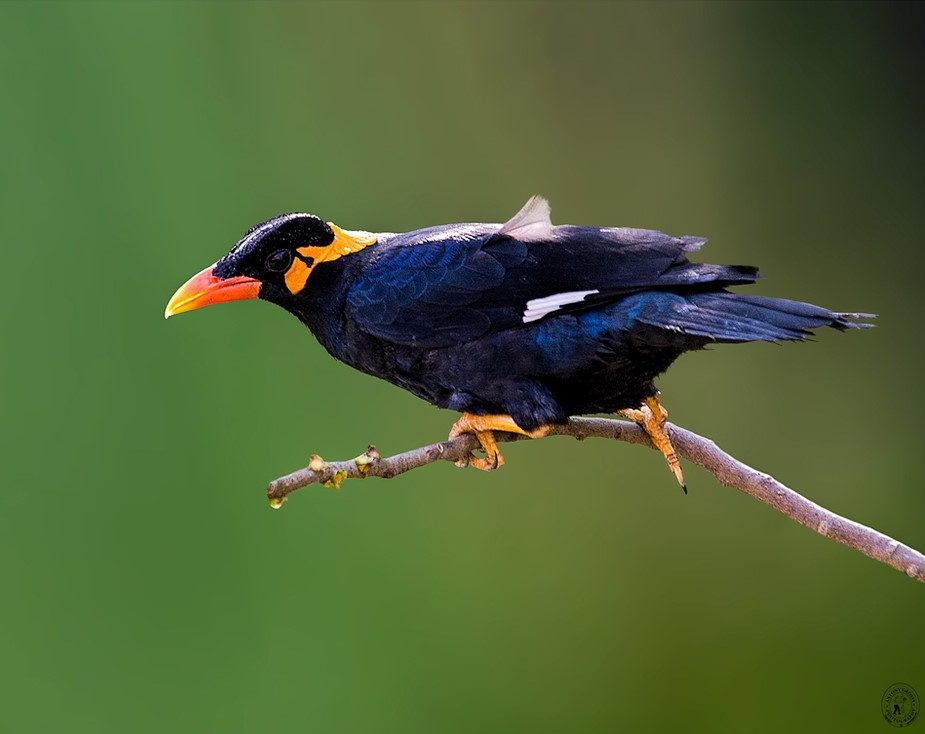
Common Hill Myna, showing a bluish gloss on the upperparts, a purplish gloss on the underparts, and a white patch at the base of the primaries. (Port Blair, South Andaman Island, India; December 24, 2013.) © Antony Grossy

Common Hill Myna, apparently an individual with an unusually thick bill. (Langkawi Islands, Malaysia; June 2004.) © Hans Stel
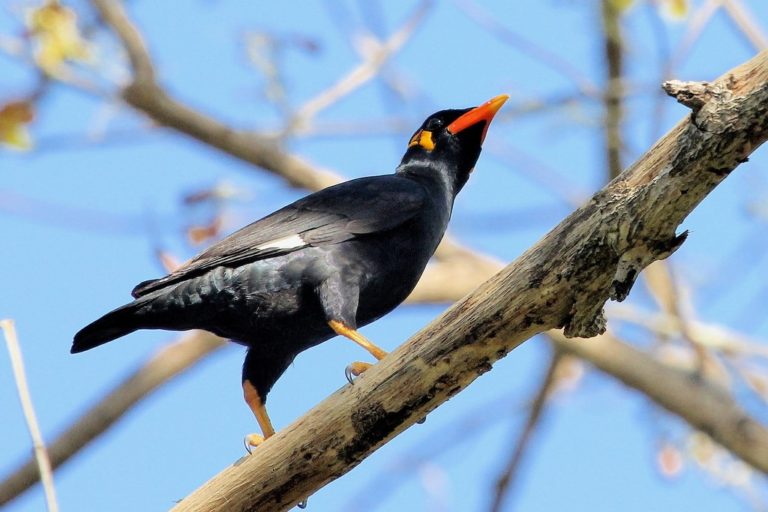
Common Hill Myna. (Fairchild Tropical Botanical Garden, Miami, Florida; March 18, 2012.) © tozjohn

Common Hill Myna. (Little Andaman Island, India; March 18, 2019.) © Solomon Sampath Kumar
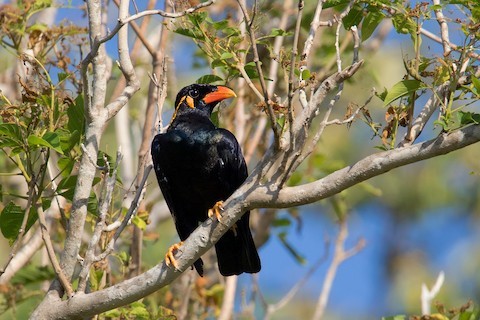
Common Hill Myna, showing heavy bill and otherwise generally robust appearance. (Surat Thani, Thailand.) © Ayuwat Jearwattanakanok
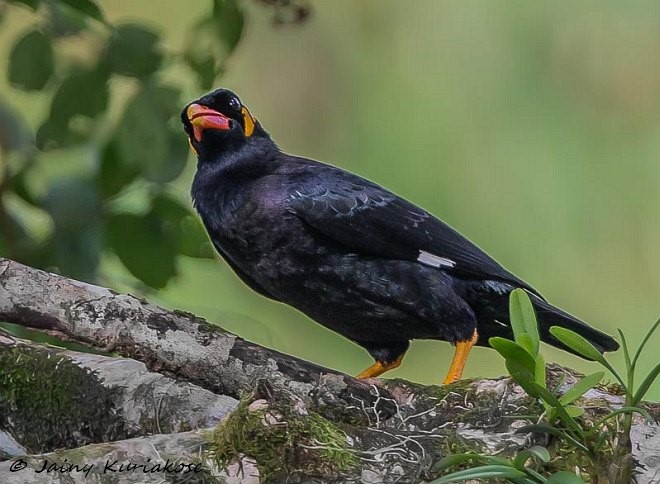
Common Hill Myna, showing purplish gloss on the underparts. (Great Nicobar Island, India; September 19, 2014.) © Jainy Kuriakose
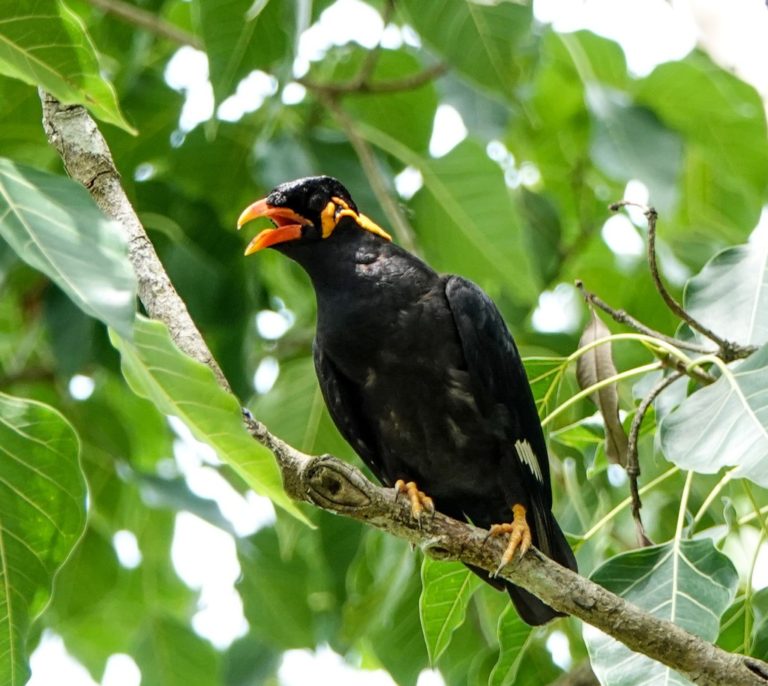
Common Hill Myna. (Karimganj, Assam, India; June 19, 2018.) © Rejoice Gassah

Common Hill Myna, dorsal view showing the shape of the wattles. (Karimganj, Assam, India; June 19, 2018.) © Rejoice Gassah
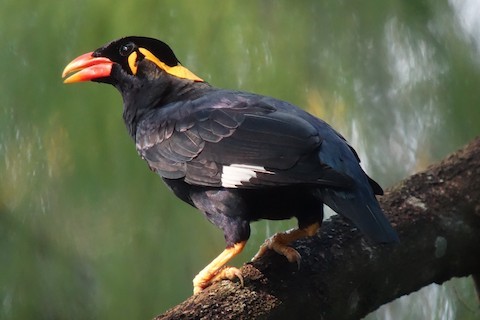
Common Hill Myna with wattles that are not connected. (Singapore Botanic Gardens, Singapore; November 3, 2019.) © Tomohiro Iuchi
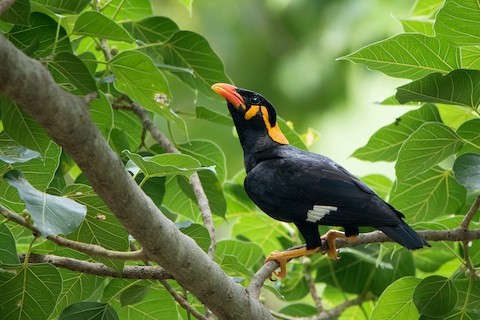
Common Hill Myna with wattles that do not connect. (Surat Thani, Thailand.) © Ayuwat Jearwattanakanok

Common Hill Myna, in flight with wattle waving in the breeze. (Henderson Waves Bridge, Singapore; November 10, 2018.) © Adrian Silas Tay

Common Hill Myna, in flight showing white patch at the base of the primaries. (Central Catchment Nature Reserve, Singapore; October 7, 2018.) © Eyzat Amer
Voice. Typical calls are loud, liquid whistled notes, often descending in tone: Khao Yai National Park, Thailand; January 1997, © Dominique Verbelen; Danum Valley, Sabah, Malaysia; September 1990, © Frank R. Lambert; Nameri National Park, Assam, India; December 21, 2009, © Abidur Rahman
The calls of “Enggano Hill Myna” (G. r. enganensis) are liquid whistled notes that seem consistent with those of other Common Hill Myna subspecies: Enggano Island, Indonesia; February 11, 2009, © Philippe Verbelen
A typical song is liquid and musical, and includes short whistles and rolling trills: Nameri National Park, Assam, India; May 8, 2009, © Pamela C. Rasmussen
Songs may also include various other sounds, some shrill, some rough: St. Paul’s National Park, Palawan, Philippines; January 1997, © Philippe Verbelen
Cf. Other Hill Mynas. The Gracula hill mynas are immediately recognizable to the genus level by the unique yellow-orange wattles that extend like flaps behind the eyes and around the back of the head. Within the group, the Sri Lanka Hill Myna (G. ptilogenys) is distinctive in having a dark-based bill and more limited wattles than the others. The others are very similar to one another and the boundaries between species have been interpreted differently over time.
Their ranges do not naturally overlap but all are heavily persecuted for the pet trade so they are subject to unnatural relocations, so there is significant potential for misidentification—especially of individuals in captivity and escapees.
As of 2020, the consensus view, adopted in the Handbook of the Birds of the World Alive, is to classify eight of the similar hill myna subspecies together as the Common Hill Myna (G. religiosa) but to recognize three as separate species: indica (Southern), venerata (Tenggara), and robusta (Nias). Each of these three differs consistently from the religiosa group.
Southern Hill Myna (G. indica) of southwestern India and Sri Lanka averages slightly small than Common and has a thinner bill. Its wattles emerge from a higher region of the crown than Common’s, and have a different shape—when seen from above or behind, the wattles form two loops. Southern’s vocalizations also differ from Common’s in being higher-pitched and screechy or wheezy.
Tenggara Hill Myna (G. venerata) of the Lesser Sunda Islands is approximately the same size as Common, but has wattles that more closely resemble Southern’s. Tenggara also has peculiar bumps on the front of its crown, and its vocalizations differ noticeably from Common’s in having a nasal, wheezy quality.
Nias Hill Myna (G. robusta) of the Nias and Banyak Islands, west of northern Sumatra, is significantly larger than Common, with a thicker bill, glossier plumage, and a proportionately larger white wing-patch.
Notes
Polytypic species consisting of eight recognized subspecies, some of which have at times been regarded as separate species. Includes the “Enggano Hill Myna” (enganensis), endemic to Enggano Island west of southern Sumatra, which was traditionally considered a separate species, but does not differ noticeably from other subspecies of religiosa.
Another Indonesian form previously included as a Common Hill Myna subspecies, venerata, of the Lesser Sunda Islands, has been reclassified as a separate species, the Tenggara Hill Myna.
References
Alderfer, J., and J.L. Dunn. 2014. National Geographic Complete Birds of North America (Second Edition). National Geographic Society, Washington, D.C.
BirdLife International. 2018. Gracula religiosa (amended version of 2017 assessment). The IUCN Red List of Threatened Species 2018: e.T103878755A135865132. https://dx.doi.org/10.2305/IUCN.UK.2018-2.RLTS.T103878755A135865132.en. (Accessed April 26, 2020.)
Craig, A., C. Feare, and D.A. Christie. 2020. Common Hill Myna (Gracula religiosa). In Handbook of the Birds of the World Alive (J. del Hoyo, A. Elliott, J. Sargatal, D.A. Christie, and E. de Juana, eds.). Lynx Edicions, Barcelona. https://www.hbw.com/node/60823. (Accessed April 26, 2020.)
eBird. 2020. eBird: An online database of bird distribution and abundance. Cornell Lab of Ornithology, Ithaca, N.Y. http://www.ebird.org. (Accessed April 26, 2020.)
Feare, C., A. Craig, B. Croucher, C. Shields, and K. Komolphalin. 1999. Starlings and Mynas. Princeton University Press, Princeton, N.J.
Kirwan, G.M., A. Levesque, M. Oberle, and C.J. Sharpe. 2019. Birds of the West Indies. Lynx Edicions, Barcelona.
Raffaele, H., J. Wiley, O. Garrido, A. Keith, and J. Raffaele. 1998. A Guide to the Birds of the West Indies. Princeton University Press, Princeton, N.J.
Robson, C. 2002. Birds of Thailand. Princeton University Press, Princeton, N.J.
